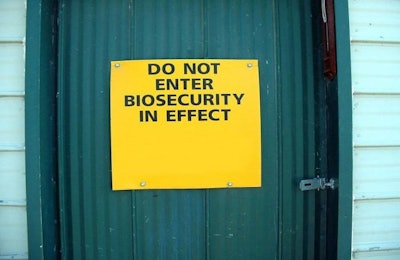
Commercial chicken farming is certainly not furthering the spread of bird flu among wild birds.
In a recent New York Times opinion article, David Quammen, a freelance science writer and author, makes a huge – and I feel incorrect – logic leap in linking large-scale chicken farming to spreading highly pathogenic avian influenza (HPAI).
Broiler farms spreading bird flu?
In an article largely calling attention the risk HPAI poses to endangered wild birds, Quammen wrote: “We should think about how our access to cheap supermarket chicken, breasts and legs wrapped in plastic, kindles jeopardy … We should bear in mind that those 33 billion broilers and roasters represent a great petri dish for the continuing evolution of flu viruses. One such virus could well — just by chance — acquire mutations that make it the next human nightmare.”
I’ve written counter-arguments when the NYT's opinion pages smeared the industry in the past, so I won’t pass up this opportunity again to put this one at the bottom of a bird cage, either.
A few weeks ago, I was at the PEAK conference in Minneapolis. There I saw Dr. Carol Cardona, Pomeroy Chair in Avian Health, University of Minnesota, speak about her experience, thoughts and predictions about HPAI in the spring of 2023.
Cardona, whom I interviewed for the May issue of WATT PoultryUSA as well, said she was warning people about the disease decades ago. She’s had first hand experience with HPAI in Minnesota twice in the last decade, too.
Commercial poultry and the spread of HPAI
Cardona said the original goose Guangdong HPAI identified in 1996 was likely spread by live marketing in China. In the second half of the 20th century, agriculture was greatly advanced in that country with the objective of advancing from small-scale individual sustenance farming operations to larger, more modern farms.
As a result, she said, live markets increased in popularity. This facilitated the spread of the disease around Asia. In 2005, the disease crossed the Urals and in 2014 it arrived in the Americas.
So, live and wet markets in rural Asia are the origin and later migratory wild birds were, and are, the major spreading factor of HPAI over the past nearly three decades.
HPAI cases in commercial poultry
HPAI costs the global poultry industry money, so all efforts are made to limit the spread of the disease.
When applicable, the combined response from government and industry to HPAI then and now has been stamping out, or attempting to completely eliminate the disease by depopulating birds in affected areas. In countries where the disease is considered endemic, HPAI vaccinations are used to preserve the domestic poultry industry.
In the U.S., when HPAI arrived to commercial operations, it likely came from wild birds. In 2014 and 2015, according to the various postmortems, humans later inadvertently spread the disease from farm to farm. Once the disease was stamped out in commercial poultry, a major effort was undertaken by national and local governments as well as the industry to step up training and biosecurity efforts to prevent a similar outbreak.
In the current U.S. outbreak, commercial poultry is facing a new challenge with constant introductions of HPAI from wild birds. Growers and integrators are looking for ways to limit these introductions and keep the spread low. The disease isn’t spreading laterally as a result. Those most affected by the disease, longer-lived poultry like layers and turkeys, are also interested in using vaccines as another tool to limit the spread of the disease and protect their animals.
How, then, are the commercial birds, in the developed world or in a modern poultry operation, a petri dish for the next pandemic? Especially given that the policy is often to kill infected birds immediately, dispose of them properly and then enact strict biosecurity measures to limit disease spread.
The truth of the matter
Quammen’s argument hopes to appeal to a reader who is: afraid of another pandemic, under-educated on animal agriculture and probably already biased against the agriculture industry. Times readers are, after all, perpetually coached by its editorial pages to feel bad about eating meat or using animal products. The author is certainly an expert on wildlife, but perhaps not domesticated animals.
Poultry growers and processors in the U.S., Europe and in countries with developed poultry industries around the world are making serious efforts to limit the spread of HPAI. They are not taking the subject lightly. In fact, the constant, global spread of the disease is forcing hard conversations around the globe about controlling the disease, living with it in wild birds and what it all means for the massive, international poultry trade.
I am no scientist, but I am the editor of WATT PoultryUSA. Based on who I’ve interviewed and what I’ve read in the past two years, mutations of the disease are often occurring in the wild bird populations and the disease is being spread around the world by migratory bird populations. These same migratory birds, which cross continents, play a large role in preserving the disease over cold months in far-flung nesting colonies, too.
Is there a link between poultry farming – a person keeping birds in an effort to make money off the meat or eggs – and this strain of HPAI's origins and spread? Yes, I can concede that contention.
Has the commercial poultry industry since allowed the disease to spread or to persist inside its barns? Certainly not. Around the world, the poultry industry is on the front line in the fight against HPAI.
Read our ongoing coverage of the global avian influenza outbreak.
















